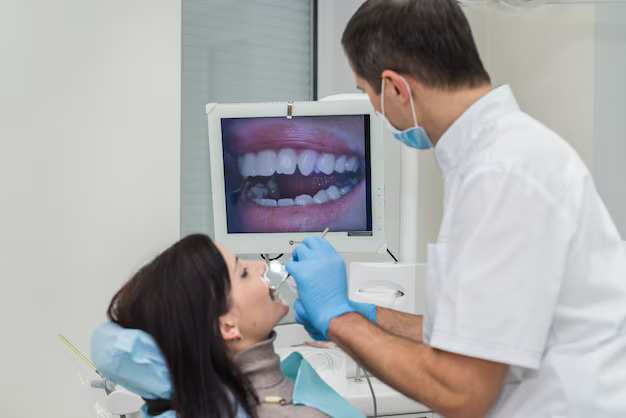The benefits of using intraoral cameras in the dental office, when to use them and how often
An Intraoral camera is a tiny wand that can take digital photos and easily store this information in dental practice management software.
Intraoral scanners can take images of the teeth to print models and create STL files to print with 3D printers.
But an intraoral camera is just a mini camera that has a light to access inside the mouth and see the dark corners of the mouth. There are lots of different uses for intraoral cameras, for example we can use them to take a patient photo to ID the patient later.
We can use them for smile assessments so the patient can see how their smile looks and it can be discussed together.
10 ways an intraoral can be used
Whether as a diagnostic tool or to help a patient see why certain treatments are necessary, there are plenty of uses for an intraoral camera. Ten of the ways an intraoral camera can be used are:

1. for before and after teeth whitening procedures.
2. for documenting veneers, crowns, bridges before and after.
3. to help document orthodontic treatments.
4. to take images of dental implants.
5. for taking photos of gum recontouring and reshaping.
6. to show tartar or areas where brushing has been missed.
7. as a tool for consulting with the patient and gaining case acceptance and approval for treatment.
8. to help a patient see a large filling so they can understand why a crown may be needed.
9. to help document and show and track progress in treatment.
10. to monitor a lesion on the gum and how it may be changing over time.
So don’t underestimate the wow factor that patients experience when they can see something that they haven’t been able to see or appreciate before.
Improve patient communication with intraoral cameras: 3 benefits of the intraoral camera
As we’ve mentioned above, the camera is a lot more than just diagnostic tool. It can also be a tool for patient education. Often in the past, a lot of time was spent trying to explain tooth problems using words and why treatment was needed.
Before using a camera, if a certain treatment was needed, the patient just had to blindly trust the dentist not really knowing exactly what the dentist was seeing and explaining.
But having a photo can really allow the dentist and the patient to look at the situation together. A photo can tell a thousand words. Intraoral oral photos can also:
1. Decrease patient anxiety
At the same time, the intraoral camera is going to let the dentist show enlarged images of
certain dental situations to the patient and just help them understand more clearly what the
issue is and why recommendations are being made for treatment.
A benefit of this is it’s going to help decrease the anxiety of the patient. They’re going to
have a better patient experience when they have more clarity of what’s needed.
This would also help with insurance claims.

2. Help with insurance claims
Sometimes there’s something that doesn’t show up on an X-ray and a photo of the tooth can really help document the need for certain treatments and the image can be sent along with other documentation to the insurance.
A photo can offer more clarity of where a tooth may have a broken cusp and the crown is needed.
The ideal frequency for taking photos depends on the patient needs and the practice’s protocols. But generally, at regular checkups, it’s probably good to take at least one photo just to show the condition of the teeth and gums, especially if there’s a large filling or
something being planned for treatment.
And the photo could help explain why this treatment’s needed for new patients.
It may be nice to get that patient photo and several images of the teeth inside the mouth just to help the patient have more clarity what we see, and let them experience that wow factor of seeing something for the first time.

3. Help with treatment planning
The intraoral camera could be useful in treatment planning.
Whenever treatment is being explained it’s nice to have that visual image to support it. And
anytime there’s a before and after treatment, it can be used to show the results of the
treatment or to document the progress of treatment.
There are digital cameras that sometimes can take a smile photo or a cosmetic photo or orthodontic photo with a larger field of view and more resolution, and that might be used in orthodontics or some cosmetic dentistry photos.
But the intraoral camera is especially useful for those closeup images of a few teeth inside of the mouth and can really help illuminate and get a closeup image of those molars in the back that no other camera can.
Also, the intraoral cameras are quick and easy without a second delay. Once you take the image, it’s connected to the dental practice management software, so you can very quickly and easily start talking to the patient about what’s needed and seen on the monitor.
Which is why it’s beneficial to make plans to incorporate the intraoral camera into your patient experience today.

